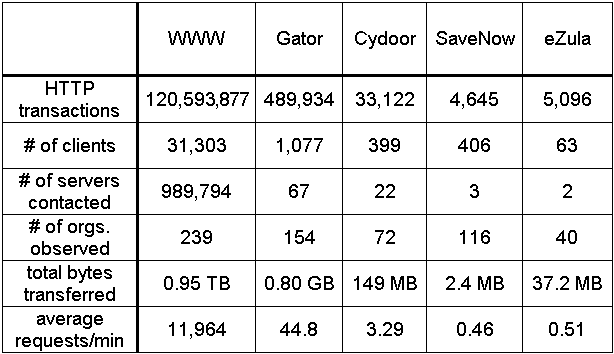Teaching:TUW - UE InfoVis WS 2008/09 - Gruppe 02 - Aufgabe 2
Aufgabenstellung
Zu beurteilende Tabelle
Critics on the table
- distracting grid
- The grid makes the table difficult to read, because it distracts the eyes. Less rulers and grid would increase the table's effectiveness [Few, 2004]. More white space around the data and the table would be clearer.

- missing labels = missing information
- The table's information isn't clearly defined, because of the missing Title/Header.
- In addition there should be a title AND subheader because of the multiple variables. Accordingly the column should be titled with the name followed by the units of measurement [Wallace, 2004].
- Figure1 shows the parts of a table and their naming.
- bad ordering of the data
- column Sequence
- The categorical subdivision should be arranged down the rows of a single column to the left of the quantitative values associated with them [Few, 2004]. Therefore the information of the table would be shown better by placing the data of the columns in the rows and the data of the rows in the columns.
- data sequence
- The data in the first row isn't ordered in a logical way, so I would prefer to place the products in an ascending or descending order. It isn't advisable to use a conventional order based on alphabetical sequence, which is useful for look-up purposes but isn't meaningful otherwise [Few, 2004].
- centered alignment of the values and the text
- -make it difficult to read the table.
- Text and numbers that represent quantitative values should always be aligned to the right [Few, 2004]. All numbers in the columns should line up with each other and their headings [Wallace, 2004], each using same number of decimal digits.
- numbers precision
- Some numbers in the table should and could be reduced without the loss of meaningful information to line up with each other in the column.
- To improve readability of the table, high numbers can be truncated to sets of three digits and be declared in the header [Few, 2004] to avoid confusion and misinterpretation as seen in the 'total bytes transferred'-row.
Correction on the table
Which changes have been made and why is the changed one better than the original table?
- The table gets a title, subtitel, a coulmn-titel also for the first column and the header-names has been easily changed, because of the multiple variables, which made the understanding of the data in the table easier.
- Only one rule is used to separate the headers of the columns and rows and push the data in the columns together, but it's enough white space left between the data in the rows and the line-headers to see a clearly separation.
- The quantitative values of the cateogirical subdivision: "WWW", "Gator", "Cydoor", "SaveNow" and "eZula" have been sequenced from left to right, so the data of the rows have been moved to the columns and vice versa, because the comparison of numbers is easier when they are stacked.
- The place of the "SaveNow"-data has been changed with the place of the "eZula"-data to get an hierachical order in the first column of the quantitative values, which looks more logical.
- The numbers and their column-headers have been aligned to the left and the text of the first column to the right to show the parts of the table clearly; like in Figure1.
- The "number of clients"- and "contacted servers"-values has been reduced to an integer. The "transferred bytes" has been truncated to MB to line up with each other in the column to make the comparison down the columns easier than the centered, different numbers and units of measurement in the table before. So I declare this units in the column-header.
References
- [Few, 2004]:Stephen Few, Show Me the Numbers: Designing Tables and Graphs to Enlighten, Analytics Press, 2004, Chapter 8 - Table Design.
- [Wallace, 2004]: Rosa Wallace, Designing Tables, NC State University LabWrite Resources, 2004.
http://www.ncsu.edu/labwrite/res/gh/gh-tables.html

